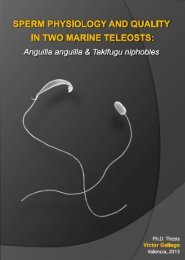8 - RiuNet - UPV
8 - RiuNet - UPV
8 - RiuNet - UPV
You also want an ePaper? Increase the reach of your titles
YUMPU automatically turns print PDFs into web optimized ePapers that Google loves.
8 th International Symposium on Fruit Flies of Economic Importance. Valencia 2010.<br />
INTRA AND INTERSPECIFIC LARVAL COMPETITION BETWEEN CERATITIS<br />
CAPITATA AND ANASTREPHA FRATERCULUS.<br />
Liendo, M. Clara *1,3 ; Devescovi, Francisco 1,3 ; Parreño, María A. 1 ; Milla, Fabián H. 1 ;<br />
Carabajal Paladino, Leonela 1,3 ; Vera, M. Teresa 2,3 ; Segura, Diego F. 1,3 & Cladera, Jorge<br />
L. 1<br />
1 Instituto Nacional de Tecnología Agropecuaria (INTA), Instituto de Genética Ewald Favret (IGEAF); De Los<br />
Reseros y N. Repetto, (1712), Castelar, Buenos Aires, Argentina. Email: mliendo@cnia.inta.gov.ar; 2 Estación<br />
Experimental Agroindustrial Obispo Colombres (EEAOC), Tucumán, Argentina; 3 CONICET.<br />
Background: Ceratitis capitata and Anastrepha fraterculus are two major fruit pests in<br />
Argentina where they are commonly found sharing its host fruit with conspecific and<br />
heterospecific larvae. As larvae are incapable of leaving the fruit, they are forced to share<br />
nutritional resources, and eventually compete for them with other larvae. Larval competition<br />
can occur by direct interference (contest) or exploitation (scramble). The impact of competition<br />
will depend both on the density of larvae within a particular fruit and the relative abundance of<br />
each species. Here we studied both the effects of competing with conspecific and<br />
heterospecific larvae for A. fraterculus and C. capitata.<br />
Methods: Intraspecific competition was analyzed by transferring newly hatched larvae into a<br />
fixed amount of larval diet at increasing densities. Interspecific competition was analyzed by<br />
keeping total density constant and transferring different proportions of larvae of the two<br />
species. We measured percentage of recovered pupae and adults, pupae weight, and larva-pupa<br />
and larva-adult developmental times.<br />
Results: Under intraspecific competition, C. capitata showed a density-dependent reduction in<br />
pupae weight and percentage of recovered pupae. A. fraterculus showed also a density<br />
dependent effect on pupae weight, and a decrease in larva-pupa developmental time.<br />
Comparing the two species, in C. capitata the reduction in pupae weight was more<br />
homogeneous among individuals, whereas in A. fraterculus a majority of pupae showed a<br />
marked decrease in weight and only few pupae showed slight negative effects. Under<br />
interspecific competition, we found that when the relative density of A. fraterculus larvae<br />
increased, the percentage of recovered pupae and the pupae weight increased for C. capitata.<br />
Likewise, A. fraterculus pupae weight increased when the relative density of C. capitata<br />
increased.<br />
Conclusions: Our results suggest that C. capitata larvae facing a shortage of resources develop<br />
a strategy of resource distribution similar to that described as scramble competition, because<br />
the individuals showed a homogeneous impact on their weight. Conversely, A. fraterculus<br />
larvae showed a response similar to that described as contest competition, because as the<br />
number of individuals in the container increases, the negative effect is not the same for every<br />
individual. Finally, we found that C. capitata and A. fraterculus larvae suffer more from<br />
sharing the resource with conspecific larvae than heterospecific larvae.<br />
Keywords: Ceratitis capitata, Anastrepha fraterculus, interspecific competition, intraspecific competition, larval<br />
competition.

















